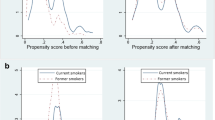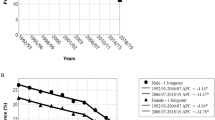Abstract
Longitudinal data from the «Berlin-Bremen Study on Health Behavior» are used to investigate smoking transitions between different stages of smoking. 1357 seventh and eighth graders were asked about their smoking behavior, their expectations with regard to smoking, smoking in their environment, and their self-image in Fall, 1983. 86% and 81% participated again one and two years later, respectively. Analyses of carbon monoxide and serum thiocyanate levels revealed adequate validity for self-reported smoking behavior. Rates of smoking were dramatically different for different educational strata. Direct and indirect functions of smoking are distinguished. The «indirect» function refers to smoking as a means of obtaining access to peer groups, thus increasing one’s psychological well-being. Direct functions refer to social and affective effects of smoking such as looking older or calming down. In line with expectations, indirect functions were found to be more important for younger adolescents and for smoking onset. In contrast, direct functions were better predictors of the smoking behavior of older adolescents and of the transition to regular smoking.
Résumé
Une étude longitudinale, la «Berlin-Bremen Study on Health Behavior» a permis d’analyser les transitions entre différents stades de l’usage du tabac. 1357 élèves de septième et huitième degrés ont été questionnés, à l’automne 1983, sur leurs attentes et habitudes relatives au tabac, les habitudes de leur environnement et leur image de soi. 86% d’entre-eux ont pu être suivis pendant un an et 81% pendant deux ans. Des analyses du monoxide de carbone et du thiocyanate sérique ont permis de conclure à une bonne validité de leurs déclarations. La fréquence d’usage du tabac s’est avérée très différente selon les types de scolarité, liés eux-mêmes à l’appartenance socio-familiale des élèves. L’usage du tabac s’est avéré par ailleurs avoir deux types de fonctions: directes et indirectes. Le fait de fumer a des «fonctions indirectes» d’intégration dans les groupes de pairs et d’accroissement du sentiment de bien- être qui en découle. Les «fonctions directes» sont d’ordre social et affectif: paraître plus âgé et se tranquilliser. L’analyse des attentes concernant le tabac a montré que les fonctions indirectes sont plus importantes pour les adolescents les plus jeunes et ceux qui commencent à fumer. A l’inverse, les fonctions directes sont plutôt celles recherchées par les fumeurs adolescents plus âgés et ceux qui commencent à fumer régulièrement.
Similar content being viewed by others
References
Abelson, R. P. (1985). A variance explanation paradox: When a little is a lot.Psychological Bulletin, 97, 129–133.
Ajzen, I., & Fishbein, M. (1980).Understanding attitudes and predicting social behavior. Englewood Cliffs, N. J.: Prentice-Hall.
Banks, M. H., Bewley, B. R., & Bland, J. M. (1981). Adolescent attitudes to smoking: Their influence on behaviour.International Journal of Health Education, 24, 39–44.
Bayerische Staatsministerien des Inneren und für Arbeit und Sozialordnung (Hrsg.) (1986).Alkohol, Drogen Medikamente, Tabak. Jugend fragt Jugend. Repräsentativerhebungen bei Jugendlichen in Bayern 1973, 1976, 1980. München.
Best, J. A., & Hakstian, A. R. (1978). A situation-specific model for smoking behavior.Addictive Behaviors, 3, 79–92.
Binder, J. (1981). Epidemiologie des Drogen-, Alkohol- und Tabakkonsums. In M. Sieber und J. Angst (Hrsg.),Drogen-Alkohol- und Tabakkonsum. Ein Beitrag zur Epidemiologie und Aetiologie bei jungen Erwachsenen (S. 55–94). Bern: Huber.
Brengelmann, J. C. (1984). Status der psychologischen Methoden der Raucherentwöhnung. In J. C. Brengelmann (Ed.),Grundlagen und Praxis der Raucherentwöhnung (pp. 47–70). München: Gerhard Röttger Verlag.
Cherry, N., & Kiernan, K. (1976). Personality scores and smoking behavior. A longitudinal study.British Journal of Preventive and Social Medicine, 30, 123–131.
Croft, J. B., Hunter, S. MacD., Webber, L. S., Watson, R. B., & Berenson, G. S. (1985). Cigarette smoking behavioral distinctions between experimental nonadopters and adopters in children and adolescents. A consideration of transitional smoking experience: The Bogalusa Heart Study.Preventive Medicine, 14, 109–122.
Cronbach, L. J. (1951). Coefficient alpha and the internal structure of tests.Psychometrika, 16, 297–334.
Dwyer, J. H. (1983).Statistical models for the social and behavioral sciences. New York: Oxford University Press.
Evans, R. I., Henderson, A. H., Hill, P. C., & Raines, B. E. (1979). Current psychological, social, and educational programs in control and prevention of smoking: Critical methodological review.Atherosclerosis Reviews, 6, 203–245.
Eysenck, H. J. (1963). Smoking, personality, and psychosomatic disorders.Journal of Psychosomatic Research, 7, 107–115.
Fishbein, M., & Ajzen, I. (1975).Belief, attitude, intention, and behavior: An introduction to theory and research. Reading, Mass.: Addison-Wesley.
Flay, B. R., d’Avernas, J. R., Best, J. A., Kersell, M. W., & Ryan, K. B. (1983). Cigarette smoking: Why young people do it and ways of preventing it. In P. Firestone & P. McGrath (Eds.),Pediatric and adolescent behavioral medicine (pp. 132–183). New York: Springer.
Gilbert, D. G. (1979). Paradoxical tranquilizing and emotion reducing effects of nicotine.Psychological Bulletin, 86, 643–661.
Hays, W. L. (1973).Statistics for the social sciences (2nd ed.) New York: Holt, Rinehart and Winston.
Hunter, S. MacD., Webber, L., & Berenson, G. S. (1980). Cigarette smoking and tobacco usage behavior in children and adolescents: The ogalusa Heart Study.Preventive Medicine, 9, 701–712.
Hunter, S. MacD., Bough, J. G., Webber, L. S., Stalor, M. C., and Berenson, G. S. (1982). Social learning effects on trial and adoptions of cigarette smoking in children: The Bogalusa Heart Study.Preventive Medicine 11, 29–42.
Hurd, P. D., Johnson, C. A., Pechacek, T., Bast, L. P., Jacobs, D. R., & Luepker, R. V. (1980). Prevention of cigarette smoking in 7th grade students.Journal of Behavioral Medicine, 3, 15–28.
Junge, B. (1985). Changes in serum thiocyanate concentration on stopping smoking.British Medical Journal, 291, 22.
Kandel, D. B. (1978). Convergences in prospective longitudinal surveys of drug use in normal populations. In D. B. Kandel (Ed.),Longitudinal research on drug use (pp. 3–38). Washington, D.C.: Hemisphere.
Kandel, D. B., Kessler, R., & Margulies, R. (1978). Adolescent initiation into stages of drug use: A developmental analysis. In D. B. Kandel (Ed.),Longitudinal research on drug use (pp. 73–100). Washington, D.C.: Hemisphere.
Kanner, A. D., Coyne, J. C., Schaefer, C., & Lazarus, R. S. (1981). Comparison of two modes of stress measurement: Daily hassles and uplifts versus major life events.Journal of Behavioral Medicine, 4, 1–39.
Kaplan, H. B. (1980).Deviant behavior in defense of self. New York: Academic Press.
Kindermann, W., & Silbereisen, R. K. (1982).Die Bewältigung alltäglicher jugendtypischer Problemsituationen: Entwicklung eines Fragebogens. Berichte aus der Arbeitsgruppe Tudrop Jugendforschung, Nr. 12 Berlin (West): Technische Universität, Institut für Psychologie.
Leventhal, H., & Avis, N. (1976). Pleasure, addiction and habit: Factors in verbal report or factors in smoking behavior?Journal of Abnormal Psychology, 85, 478–488.
Leventhal, H., & Cleary, P. D. (1980). The smoking problem: A review of the research and theory in behavioral risk modification.Psychological Bulletin, 88, 370–405.
Lippert, P., Hoffmeister, H., Thefeld, W., Lopez, H., & Eichberg, J. (1981). Cardiovascular and pulmonary risk factors in Berlin (West) schoolchildren: Finding of an exploratory study.Preventive Medicine, 19, 159–172.
Lopez, H. (1983).Rauchen bei Kindern und Jugendlichen. Weinheim: Beltz.
Maholtra, M. K. (1977). Tabakrauchende Schüler.Der Kinderarzt, 8, 967–975.
Mangan, G. L., & Golding, J. (1978). An ‘enhancement’ model of smoking maintenance? In R. E. Thornton (Ed.),Smoking behavior. Physiological and Psychological Influences (pp. 87–114), Edinburgh: Churchill Livingstone.
McKennel, A. C., & Thomas, R. K. (1967).Adults’ and adolescents’ smoking habits and attitudes. London: Her Majesty’s Stationery Office.
McKennel, A. C. (1968). British research into smoking behavior. In E. F. Borgatta & R. R. Evans (Eds.),Smoking, health and behavior (pp. 140–164). Chicagor: Aldine.
Murray, D. M., & Perry, Ch. L. (1984, August).The functional meaning of adolescent drug use. Paper presented at the 92nd Annual Meeting of the American Psychological Association, Toronto.
Newcomb, M. D., Huba, C. J., & Bentler, P. M. (1981). A multidimensional assessment of stressful life events among adolescents: Derivations and correlates.Journal of Health and Social Behavior, 22, 400–415.
Norem-Hebeisen, A., & Hedin, D. (1981). Influences on adolescent problem behavior: causes, connections, and contexts. In NIDA (Ed.),Adolescent peer pressure (pp. 21–46). Washington, D.C.: U.S. Department of Health and Human Services (DHHS Publication No. (ADM) 84-1152).
Pechacek, T. F., Murray, D. M., Luepker, R. V., Mitelemark, M. B., Johnson, C. A., & Shutz, J. B. (1984). Measurement of adolescent smoking behavior: Rationale and methods.Journal of Behavioral Medicine, 7, 123–140.
Piers, E. V., & Harris, D. B. (1969).The Piers-Harris Children’s Self-Concept Scale. Nashville: Counselor Recording and Tests.
Randolph, E. V., & Dye, C. A. (1981). The Peter Pan Profile. Development of a scale to measure reluctance to grow up.Adolescence, 16, 841–850.
Reynolds, C. R., & Richmond, B. O. (1978). What I Think and Feel: A revised measure of children’s manifest anxiety.Journal of Abnormal Child Psychology, 6, 271–280.
Rosenberg, M. (1965).Society and the Adolescent Self-Image. Princeton, N. J.: Princeton University Press.
Rosenberg, M. (1979):Conceiving the Self. New York: Basic Books.
Salber, E. J., Freeman, H. E., & Abelin, T. (1968). Needed research on smoking: Lessons from the Newton study. In E. F. Borgatta & R. R. Evans (Eds.),Smoking, health, and behavior (pp. 128–139). Chicago: Aldine.
Schachter, S. (1980). Urinary pH and the psychology of nicotine addiction. In P. O. Davidson & S. M. Davidson (Eds.),Behavioral medicine: Changing health lifestyles (pp. 70–93). New York: Bruner/Mazel.
Schindler, A., & Semmer, N. (1987). Psychologische Skalen und Indices. In N. Semmer, P. Lippert, R. Fuchs, J. H. Dwyer, G. Rieger (Hrsg.),Gesundheitsverhalten im Kindes-und Jugendalter. Abschlussbericht. Berlin: Institut für Sozialmedizin und Epidemiologie des Bundesgesundheitsamtes und Bremen: Der Senator für Gesundheit und Sport. (Unveröff.).
Semmer, N., & Lippert, P. (1984). Was hat Gesundheitsverhalten mit Gesundheit zu tun?Bundesgesundheitsblatt, 27, 111–115.
Semmer, N. (1987).Zur Entwicklung des Rauchens bei Jugendlichen (Adolescent Smoking Development). Unpublished Habilitation thesis, Technical University of Berlin, West Germany.
Sieber, M., & Angst, J., unter Mitarbeit von J. Binder (1981).Drogen Alkohol- und Tabakkonsum. Ein Beitrag zur Epidemiologie und Ätiologie bei jungen Erwachsenen Bern: Huber.
Silbereisen, R. K., & Kastner, P. (1984). Entwicklungstheoretische Perspektiven für die Prävention des Drogengebrauchs Jugendlicher. In J. Brandtstädter & H. Gräser (Hrsg.),Entwicklungsberatung unter dem Aspekt der Lebensspanne (S. 83–102). Göttingen: Hogrefe.
Silbereisen, R. K., & Noack, P. (in press). On the constructive role of problem behavior in adolescence. In N. Bolger, A. Capri, G. Downey & M. Moorehouse (Eds.),Person and context: Developmental processes. Cambridge, MA: Cambridge University Press.
Smith, G. M. (1969). Relation between personality and smoking behavior in pre-adult subjects.Journal of Consulting Psychology, 33, 710–715.
Smith, G. (1970). Personality and smoking: A review of the empirical literature. In W. A. Hunt (Ed.),Learning mechanisms in smoking (pp. 42–61). Chicago: Aldine.
Vogt, T. M., Selvin, S., Widdowson, G., & Hulley, S. B. (1977). Expired air carbon monoxide and serum thiocyanate as objective measures of cigarette exposure.American Journal of Public Health, 67, 545–549.
Wills, T. A. (1985). Stress, coping, and tobacco and alcohol use in early adolescence. In S. Shiffman and T. A. Wills (Eds.),Coping and substance use (pp. 67–94). Orlando, FA: Academic Press.
Author information
Authors and Affiliations
Additional information
The data reported here are from the «Berlin-Bremen Study on Health Behavior in Childhood and Adolescence». The study was financed by the Federal Ministry of Health, Youth, Family and Womens Affairs, Bonn, the State Government of Bremen, and the Federal Health Office, Berlin.
Rights and permissions
About this article
Cite this article
Semmer, N.K., Dwyer, J.H., Lippert, P. et al. Adolescent smoking from a functional perspective: The Berlin-Bremen Study. Eur J Psychol Educ 2, 387–401 (1987). https://doi.org/10.1007/BF03172623
Received:
Revised:
Issue Date:
DOI: https://doi.org/10.1007/BF03172623




